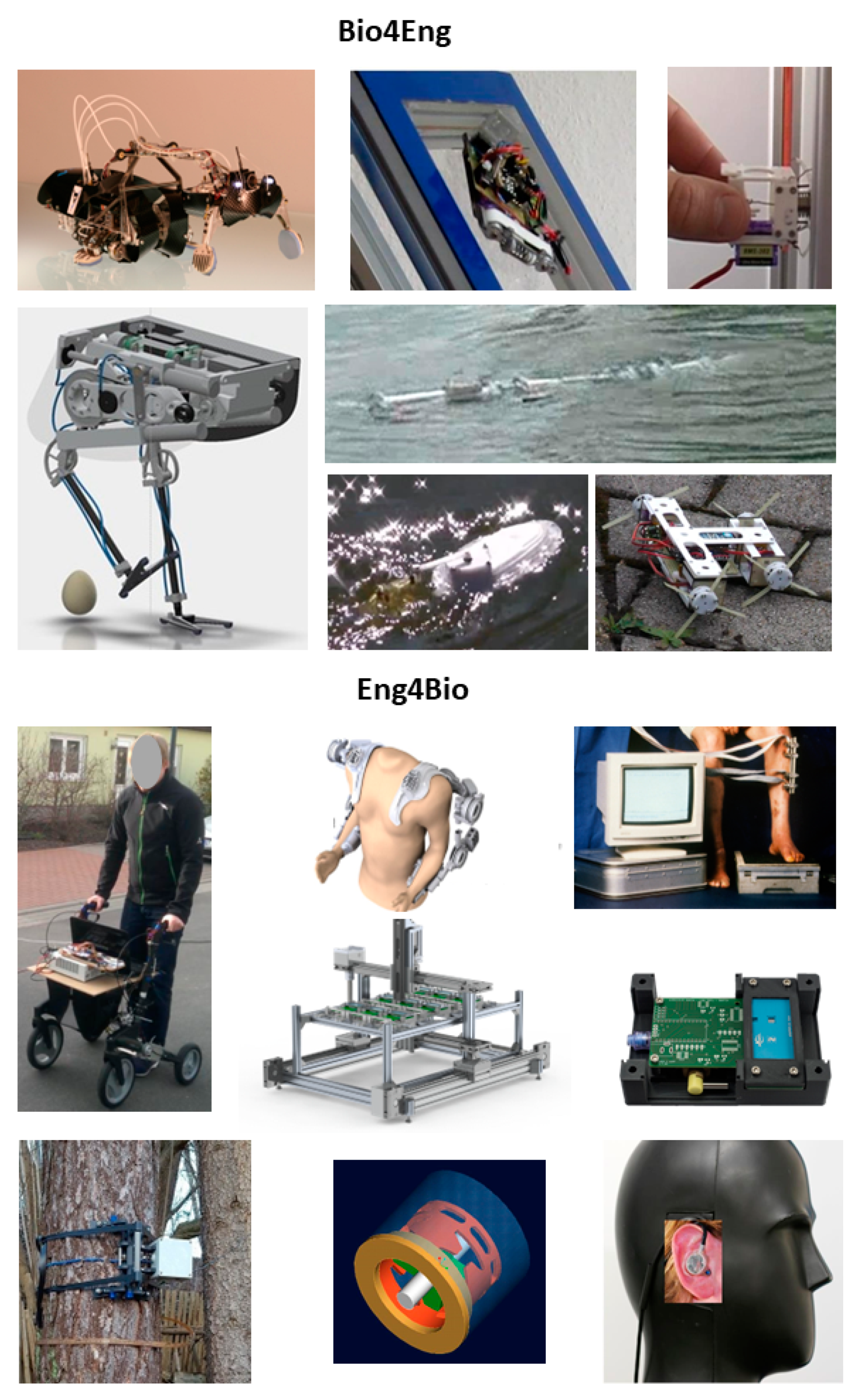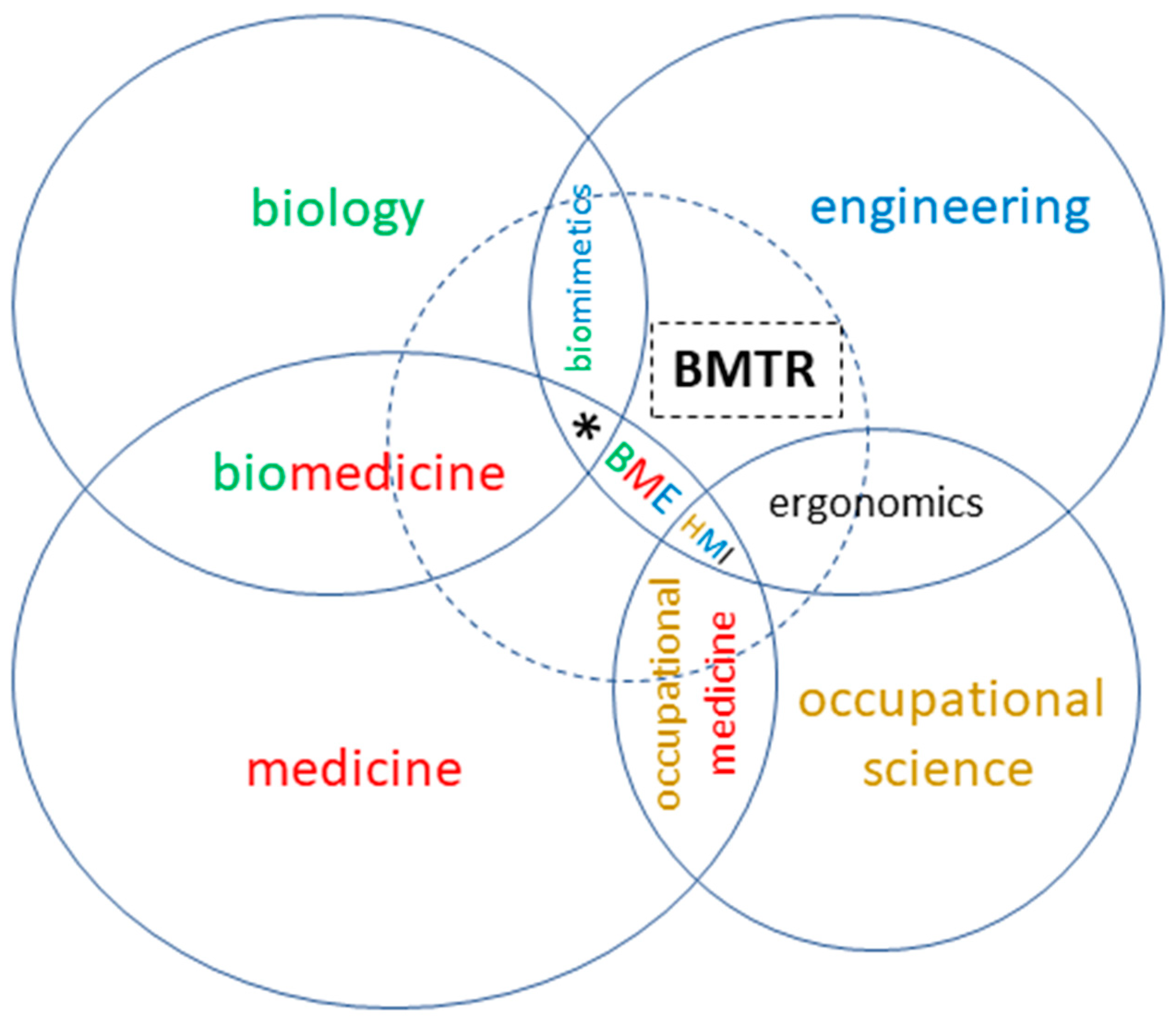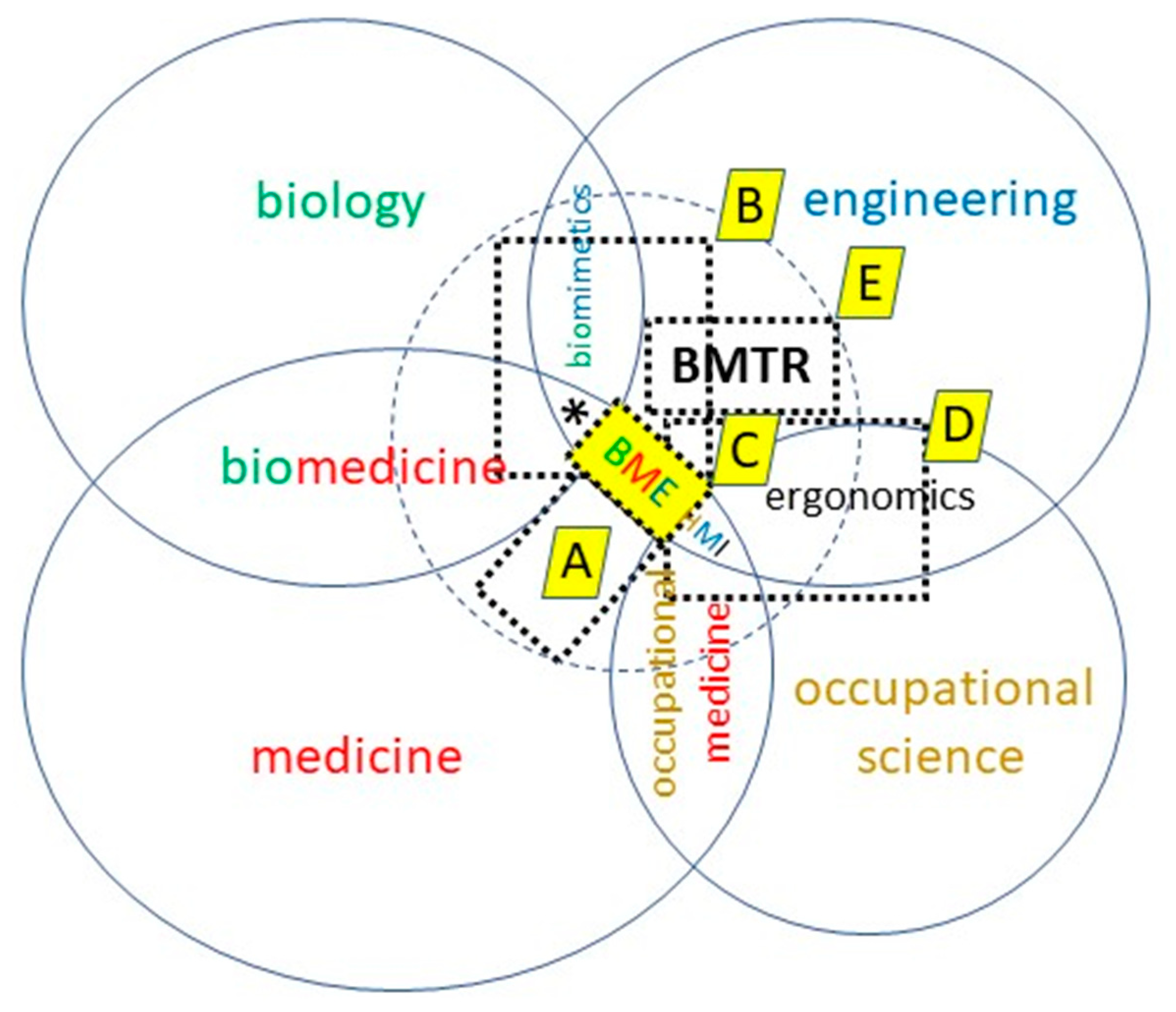The Interplay of Biomimetics and Biomechatronics
Abstract
:1. Introduction
2. Material and Methods
2.1. Problem Description
2.2. The Role of Biomimetics in Biomechatronics
2.3. Differences between Biomimetics and Biomechatronics
3. Results
3.1. Education in Biomechatronics

3.2. Intensification of Cooperation between Biomimetics and Biomechatronics for Mutual Benefit
4. Conclusions
Funding
Institutional Review Board Statement
Informed Consent Statement
Data Availability Statement
Acknowledgments
Conflicts of Interest
References
- BIOKON—Geschichte der Bionik. Available online: https://www.biokon.de/bionik/geschichte/ (accessed on 9 July 2022).
- International Standardization Organisation. DIN ISO 18458:2016-08. Biomimetics—Terminology, Concepts and Methodology, 8th ed.; Beuth Verlag GmbH: Berlin, Germany, 2015. [Google Scholar]
- Verein Deutscher Ingenieure. VDI 6220 Blatt 1, Bionik. Grundlagen, Konzeption und Strategie = Biomimetics: Fundamentals, Conception, and Strategy; VDI-Richtlinien; Beuth Verlag GmbH: Berlin, Germany, 2021. [Google Scholar]
- Herr, H.M. Crutch with Elbow and Shank Springs. U.S. Patent 19940257285 19940609, 9 June 1994. [Google Scholar]
- Herr, H. Variable-Mechanical-Impedance Artificial Legs. U.S. Patent 20030613499 20030703, 3 July 2003. [Google Scholar]
- Herr, H. Exoskeletons and orthoses: Classification, design challenges and future directions. J. Neuroeng. Rehabil. 2009, 6, 21. [Google Scholar] [CrossRef] [PubMed] [Green Version]
- Herr, H. Welcome to the bionic dawn. NEW Sci. 2015, 227, 24–25. [Google Scholar]
- Herr, H.M. Mechanisms and Methods for a Mechanical Interface between a Wearable Device and a Human Body Segment. WO Patent 2015US47442 20150828, 28 August 2015. [Google Scholar]
- Herr, H.M.; Au, S.K.; Dilworth, P.; Paluska, D.J. Artificial Ankle-Foot System with Spring, Variable-Damping, and Series-Elastic Actuator Components. U.S. Patent 20060495140 20060729, 29 July 2006. [Google Scholar]
- Herr, H.; Blaya, J.; Pratt, G.A. Active Ankle Foot Orthosis. U.S. Patent 20030671329 20030925, 25 September 2003. [Google Scholar]
- Herr, H.M.; Carney, M.E.; Rogers, E.A.; Du, L.W. Neural Efferent and Afferent Control of Spring Equilibrium, Damping, and Power in Backdrivable and Non-Backdrivable Series-Elastic Actuators Comprising Variable Series Stiffness Mechanisms. U.S. Patent 201916661483 20191023, 23 October 2019. [Google Scholar]
- Herr, H.; Carty, M.J. The Agonist-antagonist Myoneural Interface. Tech. Orthop. 2021, 36, 337–344. [Google Scholar] [CrossRef] [PubMed]
- Herr, H.M.; Casler, R.J.; Han, Z.; Barnhart, C.; Girzon, G.; Garlow, D. Controlling Torque in a Prosthesis or Orthosis. CN Patent 20118023930 20110404, 4 April 2011. [Google Scholar]
- Herr, H.M.; Casler, R. Implementing a Stand-up Sequence Using a Lower-Extremity Prosthesis or Orthosis. CN Patent 20108048597 20100831, 31 August 2010. [Google Scholar]
- Herr, H.M.; Casler, R.; Nook, C.M.; Margolin, A.S.; Size, K.J.; Kowalczyk, M.T.; Spaller, R.W.; Thompson, G.K.; Dalrymple, T.M.; Kessler, S.S.; et al. Hybrid Terrain-Adaptive Lower-Extremity Systems. U.S. Patent 20090552013 20090901, 1 September 2009. [Google Scholar]
- Herr, H.M.; Clites, T.; Maimon, B.; Zorzos, A.; Carty, M.J.; Duval, J.F.; Srinivasan, S.S. Method and System for Providing Proprioceptive Feedback and Functionality Mitigating Limb Pathology. U.S. Patent 201716068531 20170106, 6 January 2017. [Google Scholar]
- Herr, H.; Dennis, R.G. A swimming robot actuated by living muscle tissue. J. Neuroeng. Rehabil. 2004, 1, 6. [Google Scholar] [CrossRef] [PubMed] [Green Version]
- Herr, H.M.; Elliott, G.; Marecki, A.; Briner, H. Elastic Element Exoskeleton and Method of Using Same. U.S. Patent 201313774774 20130222, 22 February 2013. [Google Scholar]
- Herr, H.M.; Endo, K.; Krishnaswamy, P.; Markowitz, J.; Eilenberg, M.F.; Wang, J. Neuromuscular Model-Based Sensing and Control Paradigm for a Robotic Leg. U.S. Patent 201313865840 20130418, 18 April 2013. [Google Scholar]
- Herr, H.M.; Gamow, R.I. Shoe and Foot Prosthesis with Bending Beam Spring Structures. U.S. Patent 19940346087 19941129, 29 November 1994. [Google Scholar]
- Herr, H.M.; Geyer, H.; Eilenberg, M.F. Model-Based Neuromechanical Controller for a Robotic Leg. U.S. Patent 20100698128 20100201, 1 February 2010. [Google Scholar]
- Herr, H.M.; Grabowski, A.M. Bionic ankle-foot prosthesis normalizes walking gait for persons with leg amputation. Proc. R. Soc. B-Biol. Sci. 2012, 279, 457–464. [Google Scholar] [CrossRef] [PubMed] [Green Version]
- Herr, H.M.; Handford, M.L.; Williams, C.C.; Carney, M.E.; Levine, D.V. Computer-Controlled Ankle-Foot Prosthesis with Series J-Spring Actuation. U.S. Patent 202117455884 20211119, 19 November 2021. [Google Scholar]
- Herr, H.M.; Hofmann, A.G.; Popovic, M.B. Biomimetic Motion and Balance Controllers for Use in Prosthetics, Orthotics and Robotics. U.S. Patent 20060499853 20060804, 4 August 2006. [Google Scholar]
- Herr, H.M.; Huang, G.T.; McMahon, T.A. A model of scale effects in mammalian quadrupedal running. J. Exp. Biol. 2002, 205, 959–967. [Google Scholar] [CrossRef] [PubMed]
- Herr, H.M.; Kuan, J.Y. Robotic System for Simulating a Wearable Device and Method of Use. U.S. Patent 201213722246 20121220, 20 December 2012. [Google Scholar]
- Herr, H.M.; Moerman, K.M.; Sengeh, D.M. Method and System for Designing a Biomechanical Interface Contacting a Biological Body Segment. U.S. Patent 201716069837 20170112, 12 January 2017. [Google Scholar]
- Herr, H.M.; Martinez, V.E.C.; Weber, J.A. Powered Artificial Knee with Agonist-Antagonist Actuation. CN Patent 20108015207 20100201, 1 February 2010. [Google Scholar]
- Herr, H.M.; Marecki, A.; Sengeh, D.M. Variable Impedance Mechanical Interface. U.S. Patent 201313836835 20130315, 15 March 2013. [Google Scholar]
- Herr, H.M.; Moerman, K.M.; Solav, D.; Ranger, B.J.; Steinmeyer, R.; Ku, S.L.; Dagdeviren, C.; Carney, M.; Prieto, G.G.A.; Zhang, X.; et al. Quantitative Design and Manufacturing Framework for a Biomechanical Interface Contacting a Biological Body Segment. U.S. Patent 201916969142 20190212, 12 February 2019. [Google Scholar]
- Herr, H.M.; Mooney, L.M.; Rouse, E.J.; Kuan, J.Y. Optimal Design of a Lower Limb Exoskeleton or Orthosis. WO Patent 2014US70636 20141216, 16 December 2014. [Google Scholar]
- Herr, H.M.; Paluska, D.J.; Dilworth, P. Artificial Human Limbs and Joints Employing Actuators, Springs, and Variable-Damper Elements. U.S. Patent 20060395448 20060331, 31 March 2006. [Google Scholar]
- Herr, H.M.; Petron, A. Physiological Measurement Device or Wearable Device Interface Simulator and Method of Use. U.S. Patent 201213715441 20121214, 14 December 2012. [Google Scholar]
- Herr, H.; Popovic, M. Angular momentum in human walking. J. Exp. Biol. 2008, 211, 467–481. [Google Scholar] [CrossRef] [PubMed] [Green Version]
- Herr, H.M.; Riso, R.R.; Song, K.W.; Casler, R.J., Jr.; Carty, M.J. Peripheral Neural Interface via Nerve Regeneration to Distal Tissues. U.S. Patent 201414520766 20141022, 22 October 2014. [Google Scholar]
- Herr, H.; Rogers, E. Leaf Spring with High Resolution Stiffness Control. WO Patent 2021US49526 20210908, 8 September 2021. [Google Scholar]
- Herr, H.; Seyfarth, A.; Geyer, H. Speed-Adaptive Control Scheme for Legged Running Robots. U.S. Patent 20030750573 20031231, 31 December 2003. [Google Scholar]
- Herr, H.; Song, H.; Srinivasan, S. Mechanoneural Interfaces for Prosthetic Control. WO Patent 2021US14355 20210121, 21 January 2021. [Google Scholar]
- Herr, H.; Stolyarov, R.; Mooney, L.; Taylor, C.; Carney, M. Kinetic Sensing, Signal Generation, and Pattern Recognition for Control of Autonous Wearable Leg Devices. WO Patent 2017US60710 20171108, 8 November 2017. [Google Scholar]
- Herr, H.M.; Taylor, C.; Clites, T. Method for Neuromechanical and Neuroelectromagnetic Mitigation of Limb Pathology. U.S. Patent 201816754351 20181009, 9 October 2018. [Google Scholar]
- Herr, H.; Taylor, C.; Yeon, S.; Nawrot, M. Magnetomicrometric Advances in Robotic Control. WO Patent 2021US56092 20211021, 21 October 2021. [Google Scholar]
- Herr, H.M.; Walsh, C.; Paluska, D.J.; Valiente, A.; Pasch, K.; Grand, W. Exoskeletons for Running and Walking. U.S. Patent 20060600291 20061115, 15 November 2006. [Google Scholar]
- Herr, H.M.; Weber, J.A.; Au, S.K.; Deffenbaugh, B.W.; Magnusson, L.H.; Hoffman, A.G.; Aisen, B.B.; Hofmann, A.G. Powered Ankle-Foot Prosthesis. U.S. Patent 20080157727 20080612, 12 June 2008. [Google Scholar]
- Herr, H.M.; Weber, J.A.; Casler, R.J., Jr. Biomimetic Joint Actuators. WO Patent 2012US28774 20120312, 12 March 2012. [Google Scholar]
- Herr, H.M.; Wilkenfeld, A.; Bleck, O. Speed-Adaptive and Patient-Adaptive Prosthetic Knee. U.S. Patent 20010823931 20010329, 29 March 2001. [Google Scholar]
- Herr, H.M.; Williams, C.; Barnhart, C.E.; Han, Z.; Rohrs, C.E.; Casler, R.J., Jr. Biomimetic Transfemoral Prosthesis. WO Patent 2012US63395 20121102, 2 November 2012. [Google Scholar]
- Herr, H.; Yeon, S. Electromyography Sensor. WO Patent 2020US54904 20201009, 9 October 2020. [Google Scholar]
- Herr, H.M.; Weber, J.A.; Casler, R. Transdermal Optogenetic Peripheral Nerve Stimulation. U.S. Patent 20090552028 20090901, 1 September 2009. [Google Scholar]
- Herr, H.M.; Han, Z.; Barnhart, C.E.; Casler, R. Prosthetic, Orthetic or Exoskeleton Devise. WO Patent 2013US45356 20130612, 12 June 2013. [Google Scholar]
- Brody, H. 10 Emerging Technologies. Technol. Rev. 2005, 108, 33–46. [Google Scholar]
- Garza-Ulloa, J. Chapter 1—Introduction to biomechatronics/biomedical engineering//Introduction to biomechatronics/biomedical engineering. In Applied Biomechatronics Using Mathematical Models; Elsevier: Amsterdam, The Netherlands; pp. 1–51.
- Liu, P.X.; Gu, J. Introduction: Advances of Biorobotics and Biomechatronics. Int. J. Robot. Autom. 2007, 22, 100. [Google Scholar]
- Brooker, G.M. Introduction to Biomechatronics; Brooker, G.M., Ed.; Institution of Engineering and Technology: Stevenage, UK, 2012; pp. 1–8. [Google Scholar]
- Witte, H.; Lutherdt, S.; Schilling, C. Biomechatronics: How much biology does the engineer need? In Proceedings of the 2004 IEEE International Conference on Control Applications, Taipei, Taiwan, 2–4 September 2004; FrA-K-8. p. 6. [Google Scholar]
- Witte, H.; Fremerey, M.; Weyrich, S.; Mampel, J.; Fischheiter, L.; Voges, D.; Zimmermann, K.; Schilling, C. Biomechatronics is not just biomimetics. In RoMoCo ‘13: Workshop Proceedings, Proceedings of the 9th International Workshop on Robot Motion and Control, Wasowo, Poland, 3–5 July 2013; IEEE: Piscataway, NJ, USA, 2013; pp. 74–79. [Google Scholar]
- What Is Biomedical Engineering? Michigan Technological University: Houghton, MI, USA, 2021; Available online: https://www.mtu.edu/biomedical/department/what-is/ (accessed on 9 July 2022).
- Witte, H. The Concept of Biomechatronic Systems as a Means to Support the Development of Biosensors. IJBSBE 2017, 2, 114–115. [Google Scholar] [CrossRef] [Green Version]
- Friedrich, O.; Haug, M.; Reischl, B.; Prölß, G.; Kiriaev, L.; Head, S.I.; Reid, M.B. Single muscle fibre biomechanics and biomechatronics—The challenges, the pitfalls and the future. Int. J. Biochem. Cell Biol. 2019, 114, 105563. Available online: https://www.sciencedirect.com/science/article/pii/S1357272519301347 (accessed on 14 June 2022). [CrossRef] [PubMed]
- Haug, M.; Reischl, B.; Prölß, G.; Pollmann, C.; Buckert, T.; Keidel, C.; Schürmann, S.; Hock, M.; Rupitsch, S.; Heckel, M.; et al. The MyoRobot: A novel automated biomechatronics system to assess voltage/Ca2+ biosensors and active/passive biomechanics in muscle and biomaterials. Biosens. Bioelectron. 2018, 102, 589–599. [Google Scholar] [CrossRef] [PubMed]
- Mampel, J.; Andrada, E.; Witte, H.; Trommer, C.; Schweitzer, M.; Karguth, A.; Schmidt, A.; Fischer, M.S. Mechanical design of a climbing robot based on biomechanical analyses. In Emerging Trends in Mobil Robotics; World Scientific: Singapore; pp. 367–374.
- Witte, H.; Recknagel, S.; Kaufmann, C.; Hegelmaier, C.; Kozuschek, W.; Preuschoft, H. In Vivo-Messung der Relativbewegungen von Fragmenten gebrochener Langknochen. Biomed. Eng. 1995, 40, 365–366. [Google Scholar] [CrossRef]
- Jiménez López, O.E. Development of Biomechatronic Devices for Measurement of Wrenches Occurring in Animal and Human Prehension; Berichte aus der Biomechatronik 9; Technische Universität Ilmenau/Universitätsbibliothe; Universitätsverlag Ilmenau: Ilmenau, Germany, 2014. [Google Scholar]
- Müller, A. Selbstreferenzierendes Personalisiertes Miniaturisiertes Dosimeter (PMD) zur Bestimmung Individueller Belastungs-Beanspruchungs-Beziehungen; Berichte aus der Biomechatronik 4Ilmenau; Technische Universität Ilmenau/Universitätsbibliothe; Universitätsverlag Ilmenau: Ilmenau, Germany, 2009. [Google Scholar]


Publisher’s Note: MDPI stays neutral with regard to jurisdictional claims in published maps and institutional affiliations. |
© 2022 by the author. Licensee MDPI, Basel, Switzerland. This article is an open access article distributed under the terms and conditions of the Creative Commons Attribution (CC BY) license (https://creativecommons.org/licenses/by/4.0/).
Share and Cite
Witte, H. The Interplay of Biomimetics and Biomechatronics. Biomimetics 2022, 7, 96. https://doi.org/10.3390/biomimetics7030096
Witte H. The Interplay of Biomimetics and Biomechatronics. Biomimetics. 2022; 7(3):96. https://doi.org/10.3390/biomimetics7030096
Chicago/Turabian StyleWitte, Hartmut. 2022. "The Interplay of Biomimetics and Biomechatronics" Biomimetics 7, no. 3: 96. https://doi.org/10.3390/biomimetics7030096





